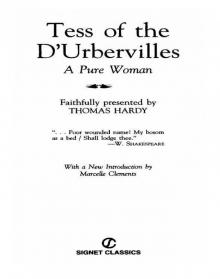- Home
- Thomas Hardy
Under the Greenwood Tree; Or, The Mellstock Quire
Under the Greenwood Tree; Or, The Mellstock Quire Read online
Transcribed by David Price, email [email protected] from the 1912Macmillan and Co. edition. Proofed by Margaret Rose Price, Dagny andDavid Price.
UNDER THE GREENWOOD TREEorTHE MELLSTOCK QUIREA RURAL PAINTING OF THE DUTCH SCHOOLby Thomas Hardy
PREFACE
This story of the Mellstock Quire and its old established west-gallerymusicians, with some supplementary descriptions of similar officials inTwo on a Tower, A Few Crusted Characters, and other places, is intendedto be a fairly true picture, at first hand, of the personages, ways, andcustoms which were common among such orchestral bodies in the villages offifty or sixty years ago.
One is inclined to regret the displacement of these ecclesiasticalbandsmen by an isolated organist (often at first a barrel-organist) orharmonium player; and despite certain advantages in point of control andaccomplishment which were, no doubt, secured by installing the singleartist, the change has tended to stultify the professed aims of theclergy, its direct result being to curtail and extinguish the interest ofparishioners in church doings. Under the old plan, from half a dozen toten full-grown players, in addition to the numerous more or less grown-upsingers, were officially occupied with the Sunday routine, and concernedin trying their best to make it an artistic outcome of the combinedmusical taste of the congregation. With a musical executive limited, asit mostly is limited now, to the parson's wife or daughter and the school-children, or to the school-teacher and the children, an important unionof interests has disappeared.
The zest of these bygone instrumentalists must have been keen and stayingto take them, as it did, on foot every Sunday after a toilsome week,through all weathers, to the church, which often lay at a distance fromtheir homes. They usually received so little in payment for theirperformances that their efforts were really a labour of love. In theparish I had in my mind when writing the present tale, the gratuitiesreceived yearly by the musicians at Christmas were somewhat as follows:From the manor-house ten shillings and a supper; from the vicar tenshillings; from the farmers five shillings each; from eachcottage-household one shilling; amounting altogether to not more than tenshillings a head annually--just enough, as an old executant told me, topay for their fiddle-strings, repairs, rosin, and music-paper (which theymostly ruled themselves). Their music in those days was all in their ownmanuscript, copied in the evenings after work, and their music-books werehome-bound.
It was customary to inscribe a few jigs, reels, horn-pipes, and balladsin the same book, by beginning it at the other end, the insertions beingcontinued from front and back till sacred and secular met together in themiddle, often with bizarre effect, the words of some of the songsexhibiting that ancient and broad humour which our grandfathers, andpossibly grandmothers, took delight in, and is in these days unquotable.
The aforesaid fiddle-strings, rosin, and music-paper were supplied by apedlar, who travelled exclusively in such wares from parish to parish,coming to each village about every six months. Tales are told of theconsternation once caused among the church fiddlers when, on the occasionof their producing a new Christmas anthem, he did not come to time, owingto being snowed up on the downs, and the straits they were in throughhaving to make shift with whipcord and twine for strings. He wasgenerally a musician himself, and sometimes a composer in a small way,bringing his own new tunes, and tempting each choir to adopt them for aconsideration. Some of these compositions which now lie before me, withtheir repetitions of lines, half-lines, and half-words, their fugues andtheir intermediate symphonies, are good singing still, though they wouldhardly be admitted into such hymn-books as are popular in the churches offashionable society at the present time.
August 1896.
Under the Greenwood Tree was first brought out in the summer of 1872 intwo volumes. The name of the story was originally intended to be, moreappropriately, The Mellstock Quire, and this has been appended as a sub-title since the early editions, it having been thought unadvisable todisplace for it the title by which the book first became known.
In rereading the narrative after a long interval there occurs theinevitable reflection that the realities out of which it was spun werematerial for another kind of study of this little group of churchmusicians than is found in the chapters here penned so lightly, even sofarcically and flippantly at times. But circumstances would haverendered any aim at a deeper, more essential, more transcendent handlingunadvisable at the date of writing; and the exhibition of the MellstockQuire in the following pages must remain the only extant one, except forthe few glimpses of that perished band which I have given in verseelsewhere.
T. H.April 1912.

 Under the Greenwood Tree; Or, The Mellstock Quire
Under the Greenwood Tree; Or, The Mellstock Quire Tess of the D'Urbervilles
Tess of the D'Urbervilles Desperate Remedies
Desperate Remedies Jude the Obscure
Jude the Obscure Two on a Tower
Two on a Tower Far from the Madding Crowd
Far from the Madding Crowd The Return of the Native
The Return of the Native The Mayor of Casterbridge
The Mayor of Casterbridge The Well-Beloved
The Well-Beloved A Laodicean : A Story of To-day
A Laodicean : A Story of To-day The Woodlanders
The Woodlanders Under the Greenwood Tree
Under the Greenwood Tree Complete Works of Thomas Hardy (Illustrated)
Complete Works of Thomas Hardy (Illustrated) Jude the Obscure (Barnes & Noble Classics Series)
Jude the Obscure (Barnes & Noble Classics Series) The Distracted Preacher
The Distracted Preacher